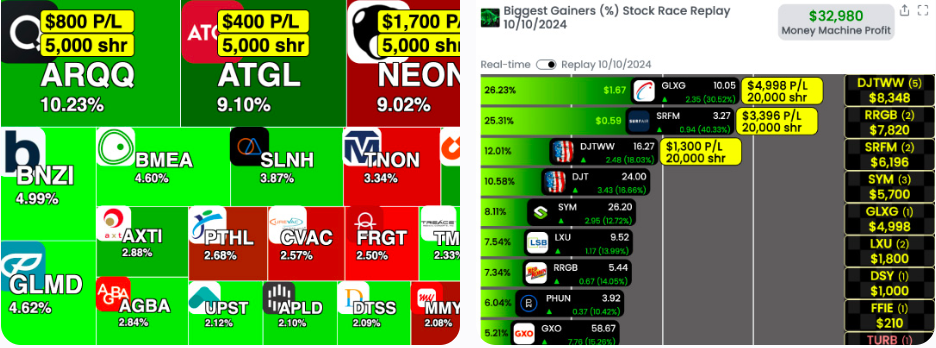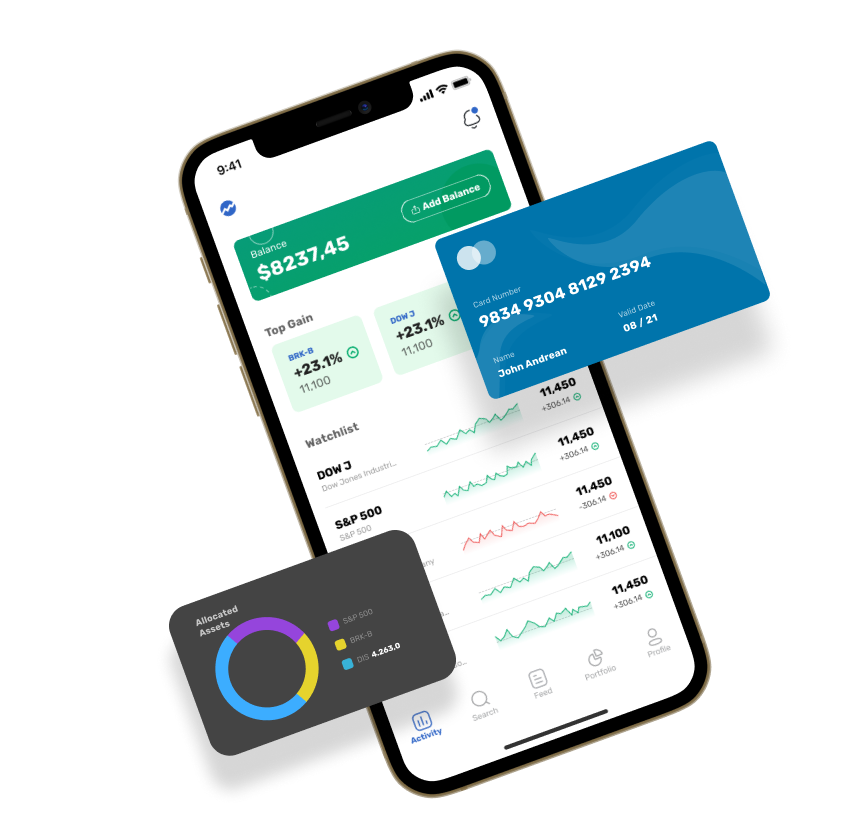20 Top Info For Choosing AI Stock Picker Platform Websites
20 Top Info For Choosing AI Stock Picker Platform Websites
Blog Article
Top 10 Ways To Assess The Market Coverage Offered By Ai-Powered Stock Predicting/Analyzing Platforms
When evaluating AI trading platforms that forecast or analyze stocks, market coverage is a key aspect to consider. It determines which assets and markets are accessible. A platform that offers comprehensive market coverage allows investors to diversify their portfolios and explore opportunities for global trading and adapt to different strategies. Here are 10 ways on how to evaluate the coverage of the platforms.
1. Evaluate Supported Asset Classes
Stocks: Make sure that the platform includes major stock exchanges (e.g., NYSE, NASDAQ, LSE, HKEX) and includes small-cap mid-cap, and large-cap stocks.
ETFs - Check to see whether your platform can support an extensive selection of ETFs that provide exposure in a number of diverse regions, sectors or themes.
Options and futures. Check if the platform is able to handle derivatives, such as options, futures and other instruments leveraged.
Forex and commodities. Find out whether there are any forex pairs that are available, in addition to precious metals, energy commodities, and other agricultural commodities.
Cryptocurrencies Make sure the platform is compatible with popular copyright like Bitcoin, Ethereum, and altcoins.
2. Check Coverage Area
Global markets. Your platform should cover the most important global markets including North America Europe Asia-Pacific and emerging countries.
Regional focus: Verify if the platform specializes in particular regions or markets that align with your business interests.
Local exchanges - Examine to find out if there are local or regional exchanges available that relate to your location and your strategy.
3. Comparing Real-Time Data to Delayed Data delayed data
Real-time information - Make sure your platform is able to provide real-time market information that will help you make timely decisions, particularly for traders who are active.
Delayed data: Find out whether you are able to get delayed data for free or at a lower cost. This could be sufficient for investors who are looking to invest long-term.
Data latency. Examine whether the platform minimizes the time it takes to process real-time feeds, especially for high-frequency trading.
4. Review the Historical Data available
Depth of historic data Check that the platform provides extensive data (e.g. over 10 years old) to test backtesting.
Check for any granularity. Historical data can include intraday, daily and weekly the granularity.
Corporate actions: Make sure that the historical data taken into account stock splits (if applicable), dividends, and any other corporate actions.
5. Review market depths and make an order for books
Level 2 data: Ensure that the platform has Level 2 information (order book depth) for improved price discovery and execution.
Verify the bid-ask ranges in order to make sure you are getting the most accurate price.
Volume data: Ensure that the platform is equipped with detailed information on volume for analysing market activity and liquidity.
6. Assess Coverage of Indices and Sectors
Major indices - Make sure your platform is compatible with major indices, like the S&P 500 (e.g. NASDAQ 100 or FTSE 100), for benchmarking based on indexes.
Information for specific industries: If you want to conduct a more specific analysis, check if there are data available for certain sectors.
Custom indexes. Check if the platform supports creating and keeping track of custom indices that meet your needs.
7. Integrate News and Sentiment Data
News feeds : Make sure you use a platform that incorporates live news feeds. Ideally, they should come from reliable media outlets (e.g. Bloomberg and Reuters), for the most important market news events.
Sentiment analysis Check to determine if your platform has sentiment analysis tools that use information from social media, news sources, or any other data source.
Event-driven strategy: Make sure that the platform is compatible with events-driven trading strategies (e.g. announcements of earnings economic reports, announcements of earnings).
8. Make sure you are aware of Multi-Market Trading Capabilities
Cross-market trade: Make sure the platform allows for trading across different markets and asset categories using a common interface.
Conversion of currency: Check if the platform allows multi-currency accounts, as well as automatic currency conversion for international trading.
Time zone support: Find out whether the trading platform you are using is compatible with different timezones to trade on global markets.
9. Review the coverage of different data sources
Alternative data: See if the platform integrates different data sources (e.g. satellite imagery internet traffic, credit card transactions) for unique insight.
ESG data - Make sure that the platform is able to provide environmental, social, and governance data (ESG). This is essential for a the socially conscious investment.
Macroeconomic Data: Ensure that the platform includes macroeconomic indicators like inflation, GDP and interest rates.
Review Customer Feedback and Market Reputation
Feedback from users is an excellent method of evaluating the market the platform's coverage.
Examine the platform's reputation. This includes awards and recognition by experts in the field.
Seek out testimonials that show the platform's effectiveness in certain assets and markets.
Bonus Tips
Trial period: Use an unpaid trial or demo to test the market coverage of the platform as well as data quality.
API access: Check if the platform's API allows accessing market data programmatically for custom analysis.
Customer support. Be sure the platform provides assistance in relation to data or market questions.
These suggestions will allow you assess the market coverage offered by AI trading platforms which predict or analyze price movements of stocks. This way you'll have the ability select the one that provides you with the data and markets you require to be successful in trading. You can increase your portfolio diversification and take advantage of new opportunities using a comprehensive market coverage. See the top https://www.inciteai.com/trader for blog info including options ai, ai investment platform, chart ai trading assistant, ai stock, chatgpt copyright, ai investing, investing ai, market ai, ai trade, ai stock trading bot free and more.
Top 10 Tips To Assess The Regulatory Compliance For Ai-Powered Stock Predicting/Analyzing Trading Platforms
Compliance with regulatory requirements plays an essential part in the evaluation of AI platforms for stock prediction and analysis. Compliance ensures that a platform complies to financial regulations and adheres to legal frameworks and protecting the user's information. This reduces the risk of financial penalties or legal issues. Here are the top 10 suggestions for evaluating the level of compliance these platforms have.
1. Verify Registration and Licensing
The regulatory bodies should ensure that your platform is registered with and licensed by relevant financial regulatory bodies (e.g., SEC in the U.S., FCA in the UK, ASIC in Australia).
Broker partnerships: Make sure that the brokers who are integrated into the platform are licensed.
Public records: Visit the website of the regulator to find the status of registration and any past violations.
2. Compliance with the Data Privacy Evaluation
GDPR In the event that you are operating or providing services to users in the EU, make sure that your platform is in compliance to the General Data Protection Regulation.
CCPA -- California Consumer Privacy Act: Check for compliance with California users.
Policies on handling data: Review the platform's data privacy policy to ensure it outlines how user data is collected as well as how it is stored and shared.
3. Evaluation of Anti-Money Laundering measures
AML policies: Make sure that your platform is equipped with robust AML policy to detect and stop any form of money laundering.
KYC Procedures: Determine if the platform has procedures in place for confirming the identities of its users.
Monitoring transactions: Ensure that the platform is monitoring transactions to detect suspicious behavior and notify authorities.
4. Verify that you're in compliance Trading Regulations
Market manipulation: Make sure the platform is equipped with measures to stop market manipulation such as washing trading or fake trading.
Types of orders: Check if the platform complies with rules regarding types of orders (e.g., no unlawful stop-loss hunting).
Best execution : Ensure that the platform is using top execution techniques to complete trades at the most competitive cost.
5. Cybersecurity compliance assessment
Data encryption: Verify that the platform safeguards users' data in transit and when it is in rest by encrypting it.
Incident response. Verify that there is an incident response strategy on the platform for cyberattacks and data breaches.
Certifications - Find out if your platform has any cybersecurity certifications.
6. Transparency as well as Disclosure and Evaluation
Fee disclosure: Ensure that the platform clearly discloses all fees, additional charges or hidden charges.
Risk disclosure: Ensure that the platform is transparent about all risks, particularly if you are using high-risk strategies or trading using leverage.
Performance reporting: Check if the AI platform's models are transparently and correctly and accurately reported.
7. Check for Compliance with International Regulations
Trading across borders. If you are planning to do international trading, ensure that your platform complies with all applicable regulations.
Tax reporting: Determine whether a platform offers tools or reports that allow users to adhere to tax laws.
Compliance with international sanctions: Make sure the platform adheres strictly to these and doesn't allow trading between prohibited countries or entities.
8. Reviewing Audit trail trails and Record-Keeping
Transaction records: Ensure that the platform has precise records for purposes of regulatory and for audit.
User activity records: Verify whether the platform is recording users' activities, such as logins or trades, as well as any changes to the account settings.
Audit-readiness: Find out if the platform is able to produce all required documentation and logs needed for an audit by a regulatory agency.
9. Check for compliance with AI-Specific Regulations
Algorithmic Trading Rules If your broker supports trading using algorithms, ensure that it is compliant with the rules such as MiFID II (in Europe) or Reg SCI (in the U.S.).
Fairness and Integrity: Determine whether the platform's AI models are monitored and controlled to avoid bias.
Explainability: Some laws require that platforms provide explanations to AI-driven decisions or predictions.
10. Review the User's Feedback and the The Regulatory History
Reviews from users: Perform studies to determine the reputation of the platform in terms of regulatory conformity.
Check the history of regulatory compliance to determine whether any violations of the regulations have been committed, as well as fines and penalties.
Third-party auditors: Find out if the platform is audited regularly by third parties to ensure that it adheres to regulations.
Bonus Tips
Legal consultations: You may consider consulting an attorney to determine whether the platform meets the applicable laws.
Trial period: Test the platform free of charge or try the demo to test the compliance features as well as the documentation.
Customer support - Make sure that the platform is able to assist with any compliance-related questions or issues.
These tips will help you assess the regulatory compliance of an AI stock-predicting/analyzing trading platform. You can select a platform that complies with legal frameworks while protecting your rights. The compliance not only reduces the risk of legal liability, but also builds trust in a platform's service. Follow the most popular see on ai stock price prediction for website info including ai trading tool, best ai penny stocks, best ai penny stocks, ai stock investing, ai options, best ai trading platform, how to use ai for copyright trading, ai software stocks, ai stock investing, ai options and more.